Rhododendron Problems: What’s Wrong With My Rhododendron?
Learn the common types of Rhododendron problems that may cause your normally care-free plant to be unhealthy and how to fix them.
Generally speaking, Rhododendrons are very care-free plants that don’t require much maintenance at all. (You can find more about caring for your Rhododendrons HERE).
However, occasionally you may run into an issue where your plants are just not looking up to par.
Since I’ve had rhododendrons in my garden for so long, I have run into a few of the common rhododendron problems over the years. So I thought I would share my experiences in case you run into the same problems and need some help.
Yellow Leaves
One potential Rhododendron problem is that the leaves are turning yellow.
According to the American Rhododendron Society, if the plant has older leaves that have turned yellow between green veins, you likely have a Magnesium deficiency. Sprinkle some Epsom Salts* around the plant to correct the issue.
If the same symptom appears in new leaves, then it is likely that the soil is too alkaline. The alkalinity prevents the plant from taking in the iron that it needs to remain healthy.
For a quick fix, you can try spraying the ground and leaves with an iron sulfate* solution. While this will provide quick relief to the plant, you will probably want to look into making your soil more acidic long term. Applying some peat moss and acidic mulching materials around the plant will eventually help to bring the soil pH down.
Find out more about soil pH, testing it and changing it HERE.
Brown Spots On The Leaves
A second type of Rhododendron issue is brown spots on the leaves. There are several types of fungus that can cause this.
With the humid summers here in SC, I always seem to have at least one Rhododendron with this problem.
To fix it, I usually clean up around the plant and try to cut back a few branches to reduce overcrowding and improve the air circulation.
Although the brown spots don’t look great, they don’t seem to bother the plant much.
Stem Die Back
Every once in a while I have a whole stem of a Rhododendron branch that dies in the middle of an otherwise healthy-looking plant. According to the Clemson University Cooperative Extension, this is caused by another kind of fungus that gets under the bark.
It usually attacks plants that are under stress due to drought, too much sun or late frosts. So the plan of attack is to cut off the dead branch as soon as possible and then try to remedy the source of the stress (if possible).
I had one plant last year that all of the stems eventually died back, and I thought it was dead. But then, much to my surprise, it started to grow some brand new shoots from the bottom. So there is a chance that your tough rhododendron may recover.
Curled Up Leaves
If you have evergreen rhododendrons and live in an area where it gets cold in the winter, you may see the leaves curl up and look pretty unhappy during a cold spell. Don’t be alarmed. The leaves are just trying to conserve water in the cold, dry air. They will open up and come back to life once it warms up.
If you see curled up leaves in the summer, though, that is a sign that your Rhododendron is much too dry. Water immediately!
Buds Don’t Open
There is nothing more disappointing than seeing your Rhododendron covered in buds and then not getting any flowers!
These are the 2 common causes of this that I’ve seen.
Bud Blast
Bud Blast is a fungal infection that causes the buds on the Rhododendron to die and turn black before they bloom.
It isn’t a life-threatening condition for the plant, but it is really disappointing for the gardener!
It is thought to be spread by the Rhododendron Leaf Hopper, an insect that doesn’t do much damage to the plant other than spreading this fungus around.
You can get insecticides to kill the bugs, but I prefer to just pick off the infected blooms as soon as I see them (less detrimental to the environment). That decreases the number of fungus spores that are available to be transported and limits the spread of the issue.
Frost Bite
If you have a late frost, it’s possible that the buds on your Rhododendrons were affected.
In this case, they usually turn a light brown color and get a little mushy (for lack of a better term). In other words, they look like they’re been frozen and thawed.
Other than covering the plant during the frost, there isn’t much you can do about this condition. But fortunately, it usually doesn’t cause any lasting damage either. Unless you are trying to grow Rhododendrons that aren’t zoned for your area…then you might want to look for some other varieties that won’t be affected so much by the cold.
Few (Or No) Flower Buds Form
Again, there are a number of reasons why you don’t have any buds on your Rhododendrons.
Incorrect Pruning Or Deadheading
The most common cause of not having any blooms is that the plant was pruned after flowering the previous year, or too much of the flower head was removed when deadheading. In this case, you’ll just have to wait it out until next year…and remember not to cut off the flowering stems 🙂
Too Much Shade
Too much shade can also cause fewer (or no) blooms. While most Rhododendrons will do fine in the shade, there are some varieties that like more sun. And almost all of them will produce more blooms if they get dappled shade, rather than total shade.
Incorrect Fertilizing
Too much fertilizer applied after the plant has finished blooming is another culprit of fewer blooms. First, since the Rhododendron roots are so shallow, too much fertilizer can stunt the growth of the whole plant. Second, fertilizer applied after the plant has finished blooming mostly promotes lots of leaves…so if you are going to fertilize, be sure to apply it at the correct time.
Not Enough Water
Letting the plant get too dried out or allowing the roots to get too hot will also affect the number of buds that form. Since the buds grow during the summer, making sure that you have a thick mulch cover and that your Rhododendrons are getting at least 1″ of water per week will help it to be as healthy as it can be.
Growth On The Stems
Lichens are a combination of algae and fungus forming a partnership to help each other grow. Generally, they don’t actually hurt the plant that they are living on, since they make their own food.
However, if your Rhododendrons have lichens growing on them, it usually means they are thinning because of poor growing conditions, disease or old age. So you may want to take a look at rejuvenating the plant, by pruning it or improving the area around it to make the plant happier.
I have seen this on plants that have become too crowded or are lacking in Magnesium (those yellow leaves from above).
More Information
If you want even more information about Rhododendron pests and problems, this guide from Washington State University has an extensive list of Rhododendron problems and how to fix them. You can get it for free online, or buy a printed copy.
Other Rhododendron Information You Might Like
- Rhododendron Care: How To Grow Beautiful Rhododendrons and Azaleas
- 7 Of The Best Azalea and Rhododendron Varieties
- How To Design A Stunning Shade Garden (With Pictures)
Have comments or questions on Rhododendron problems? Tell us in the section below.
Pin It So You Don't Forget It!
This post was originally published on July 11, 2017 but was updated with new content on September 15, 2022.
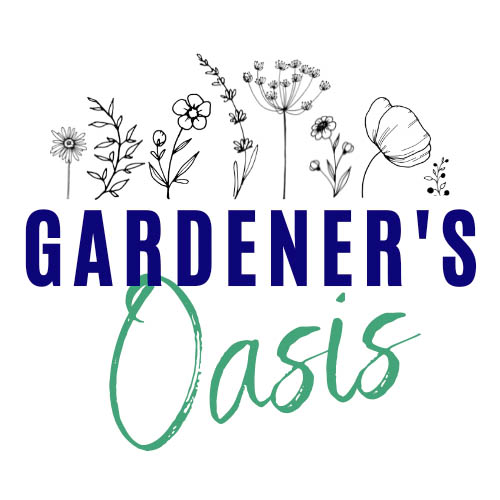
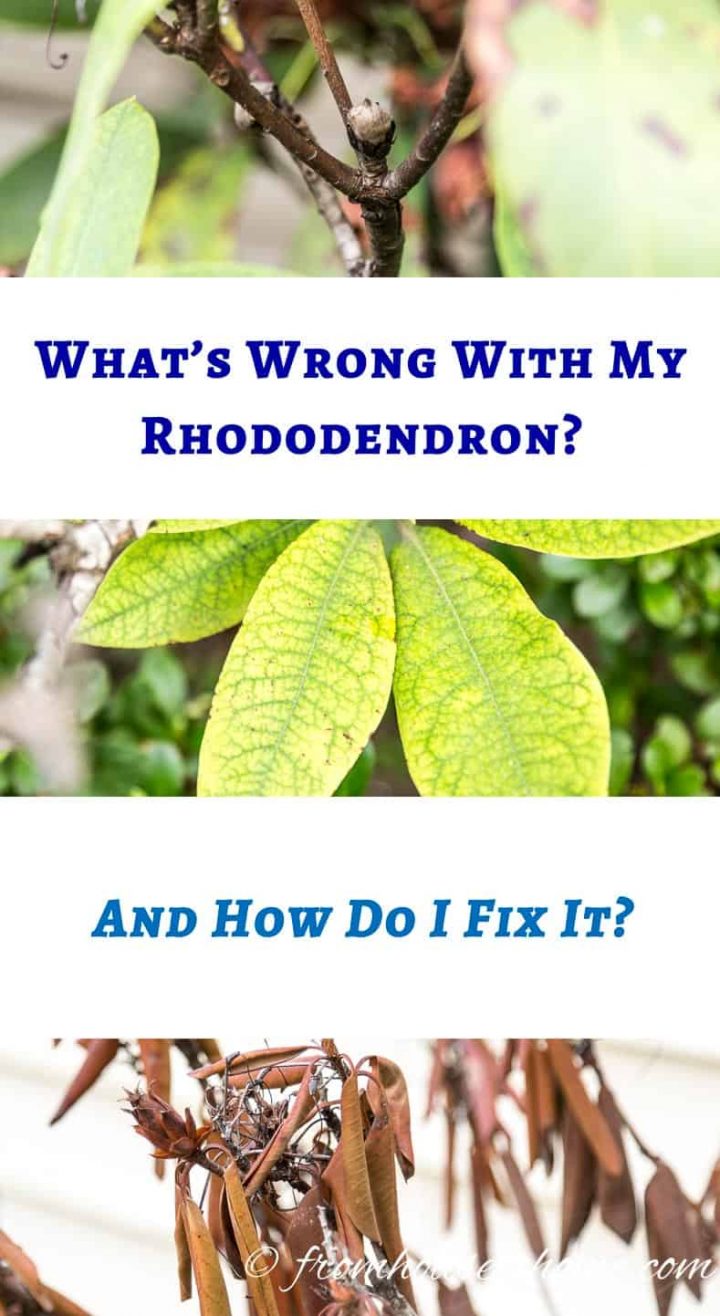
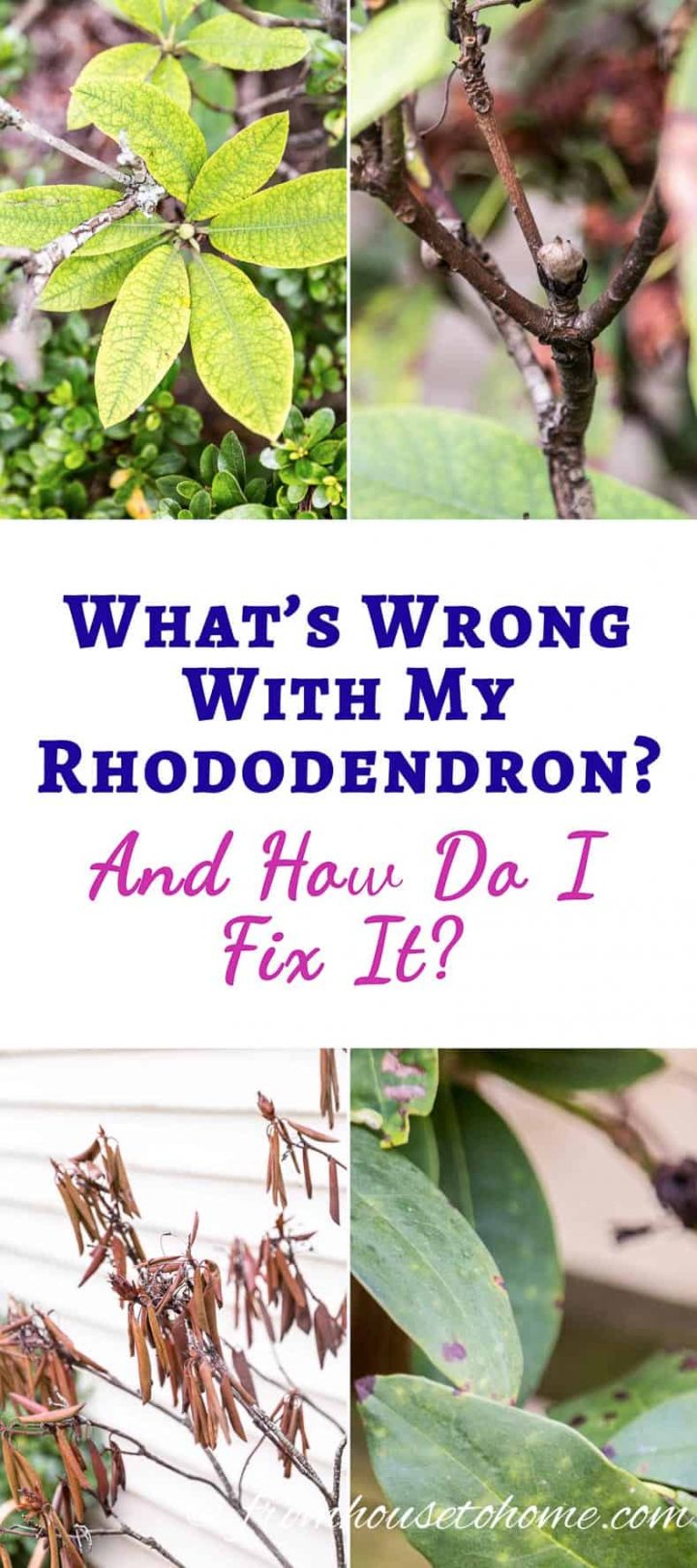
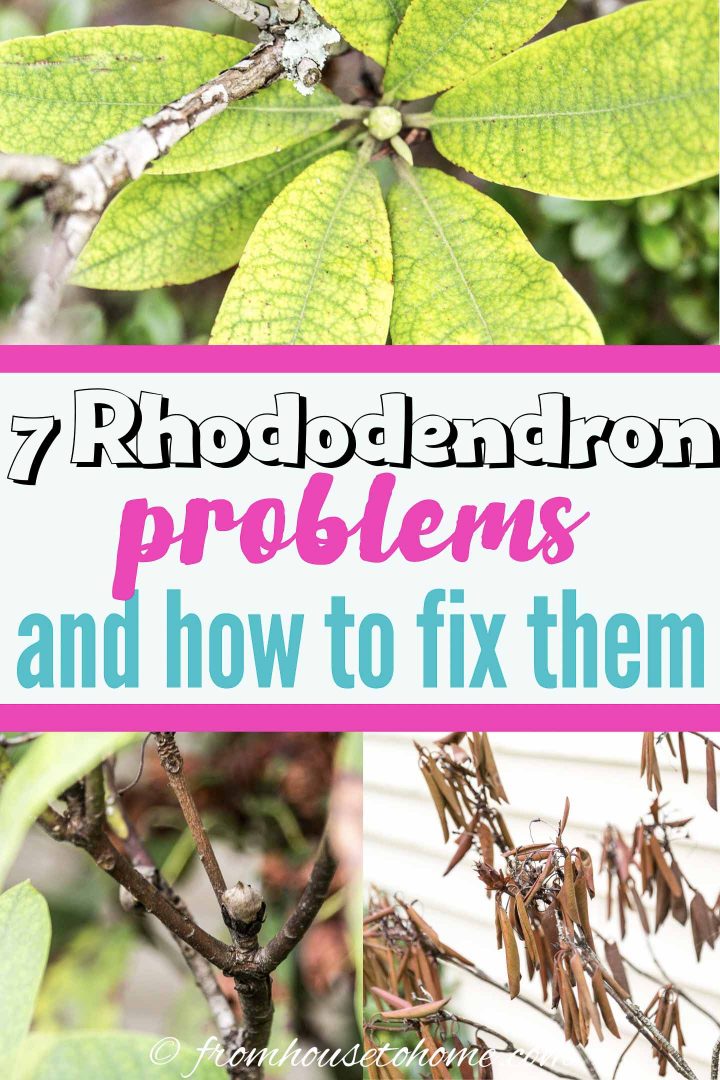
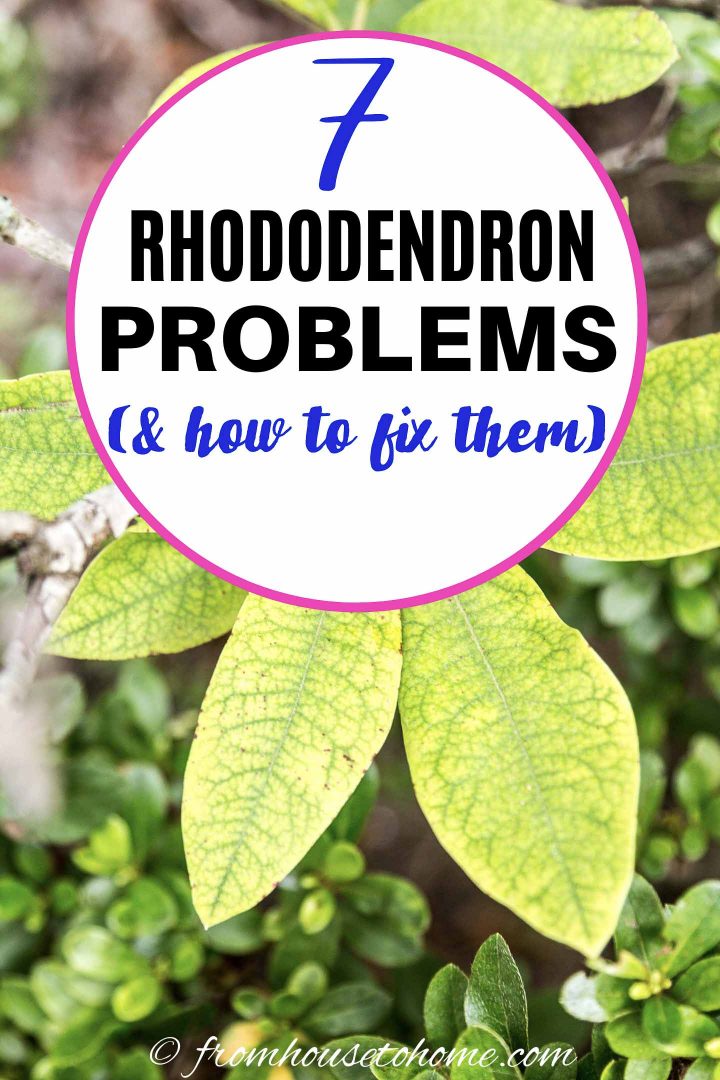
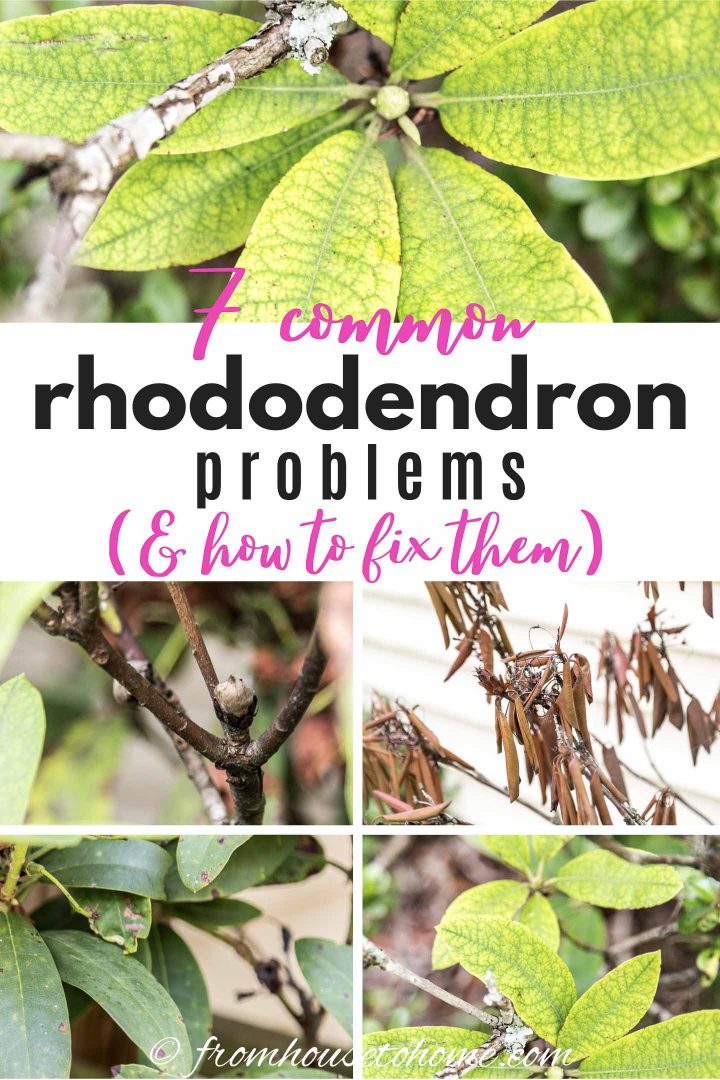
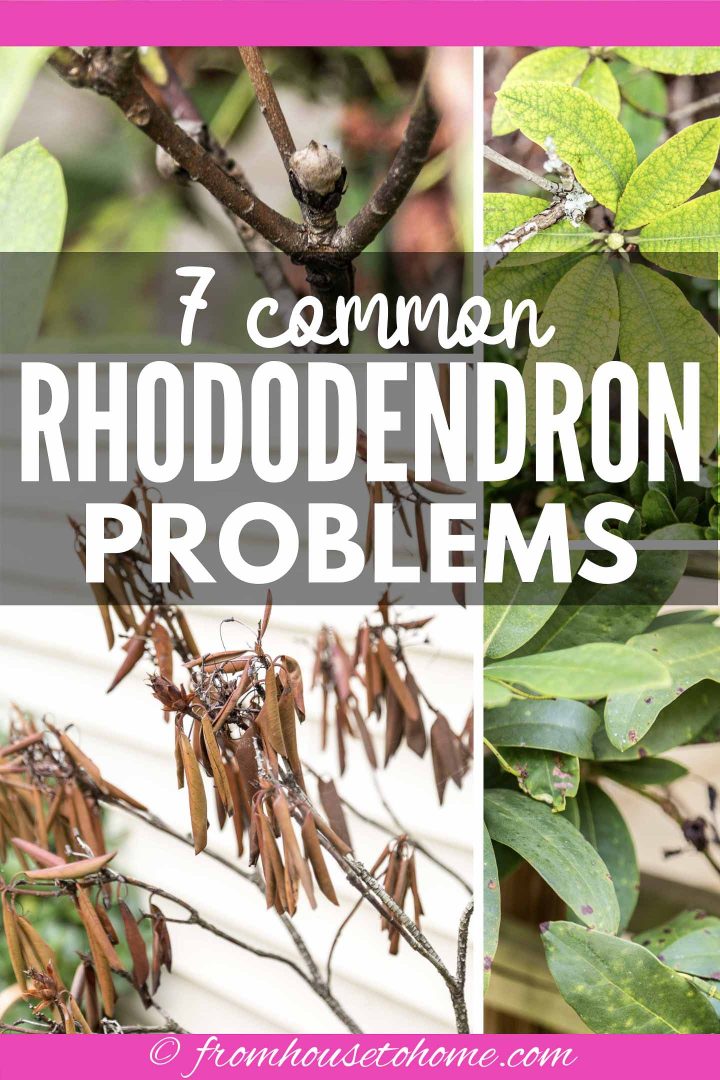
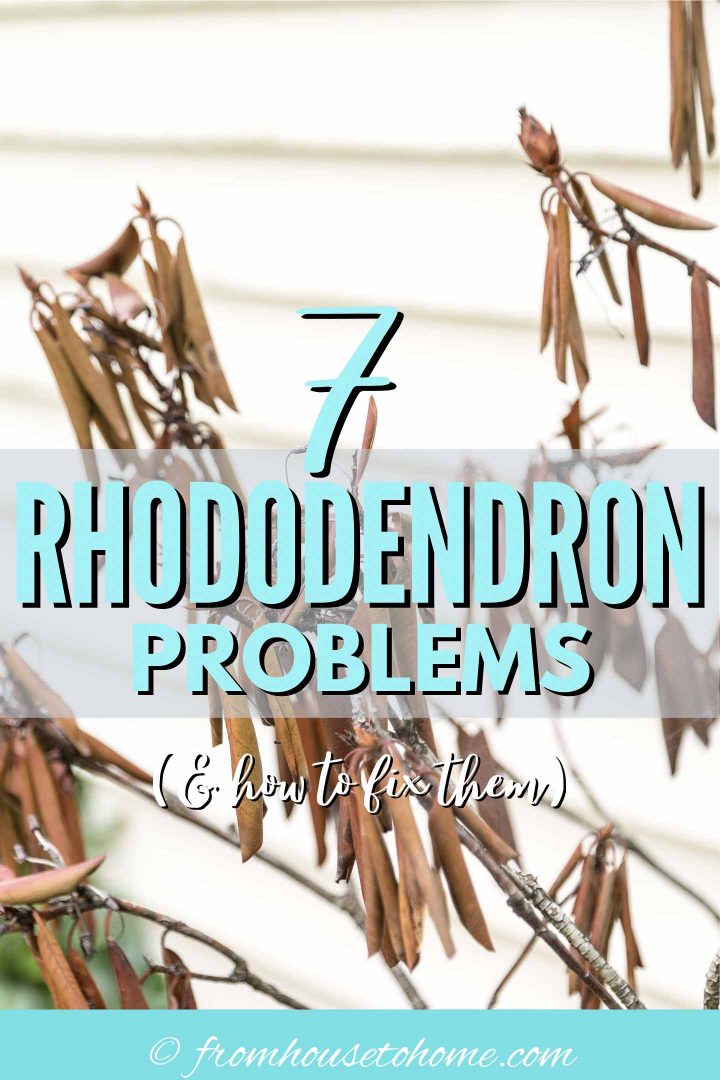
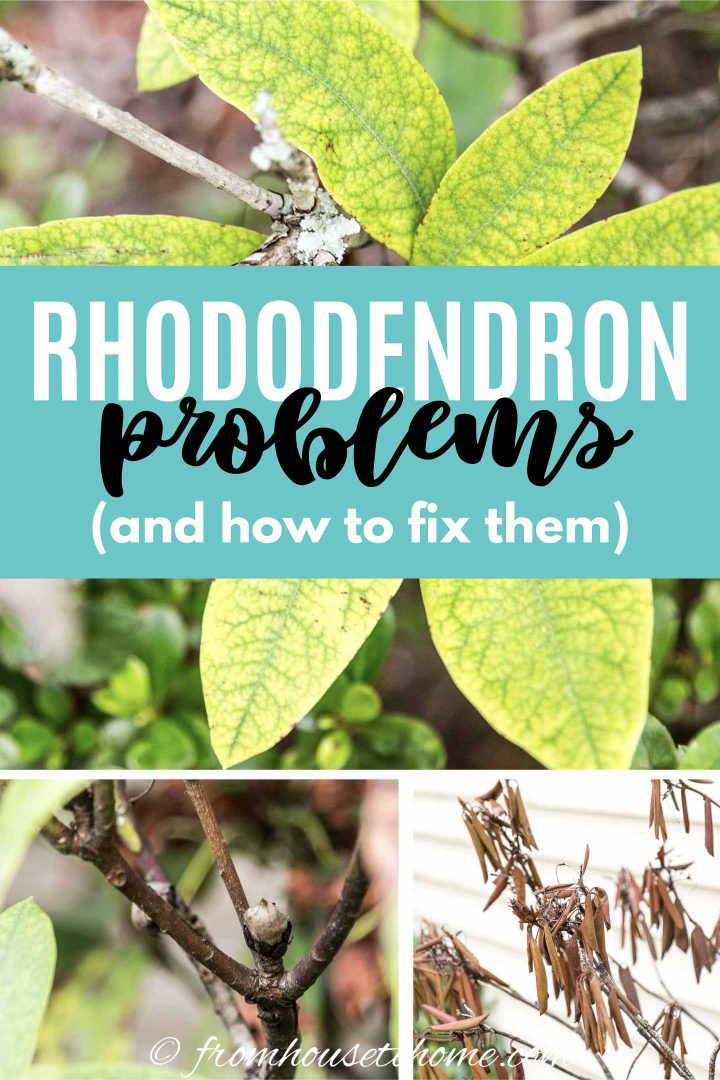
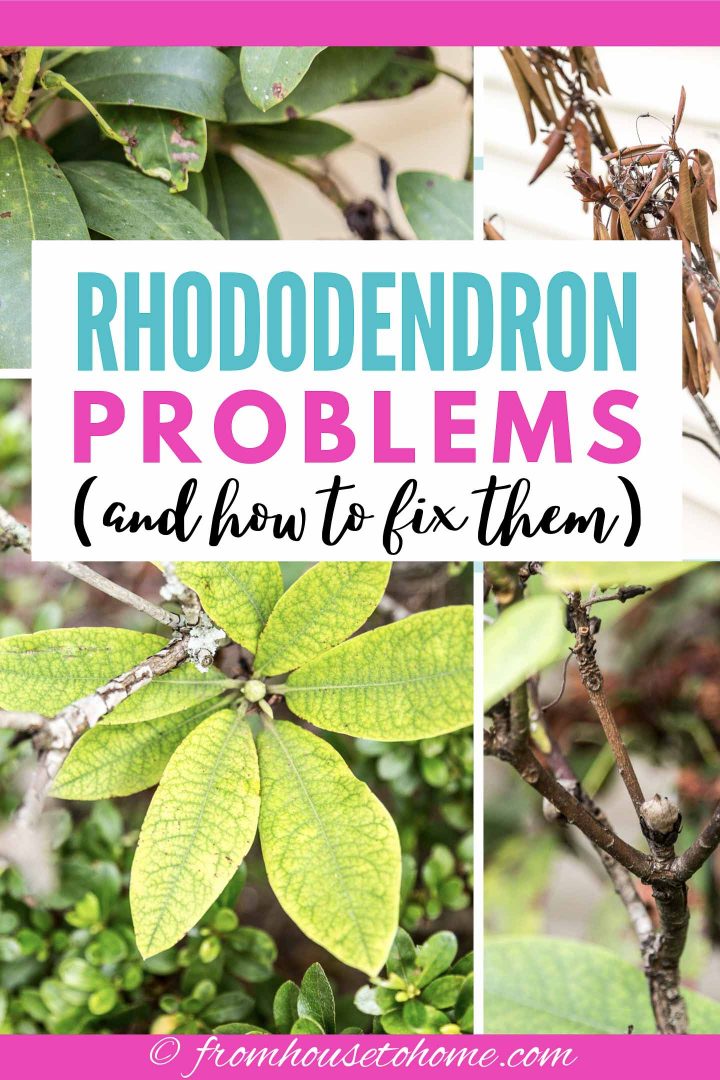
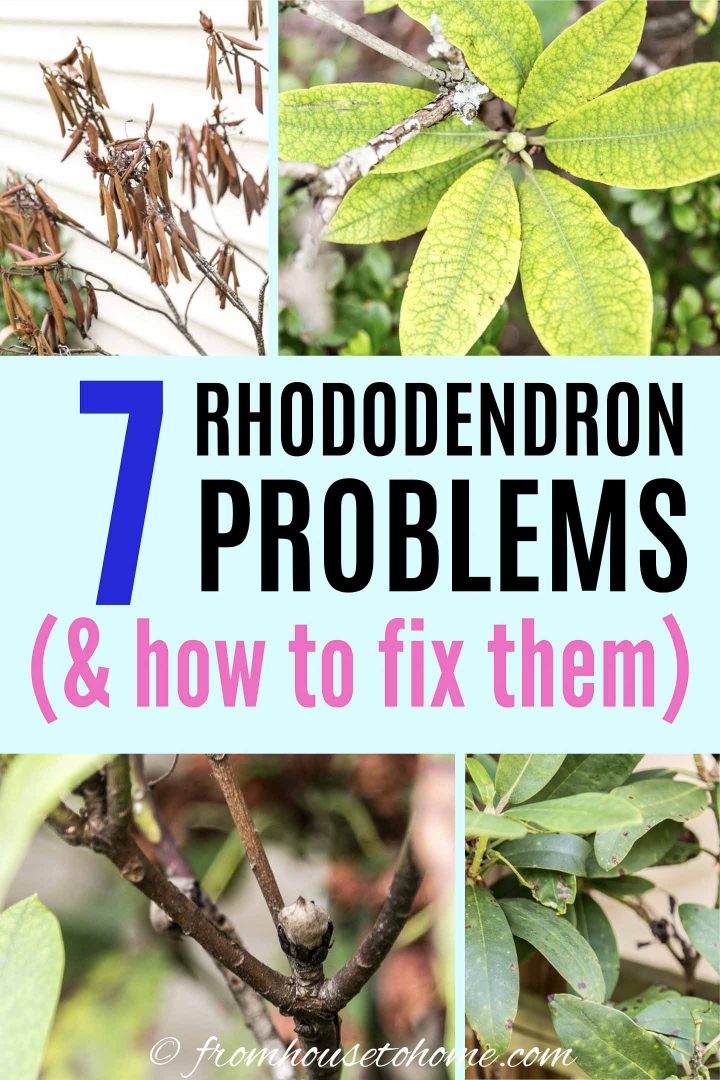
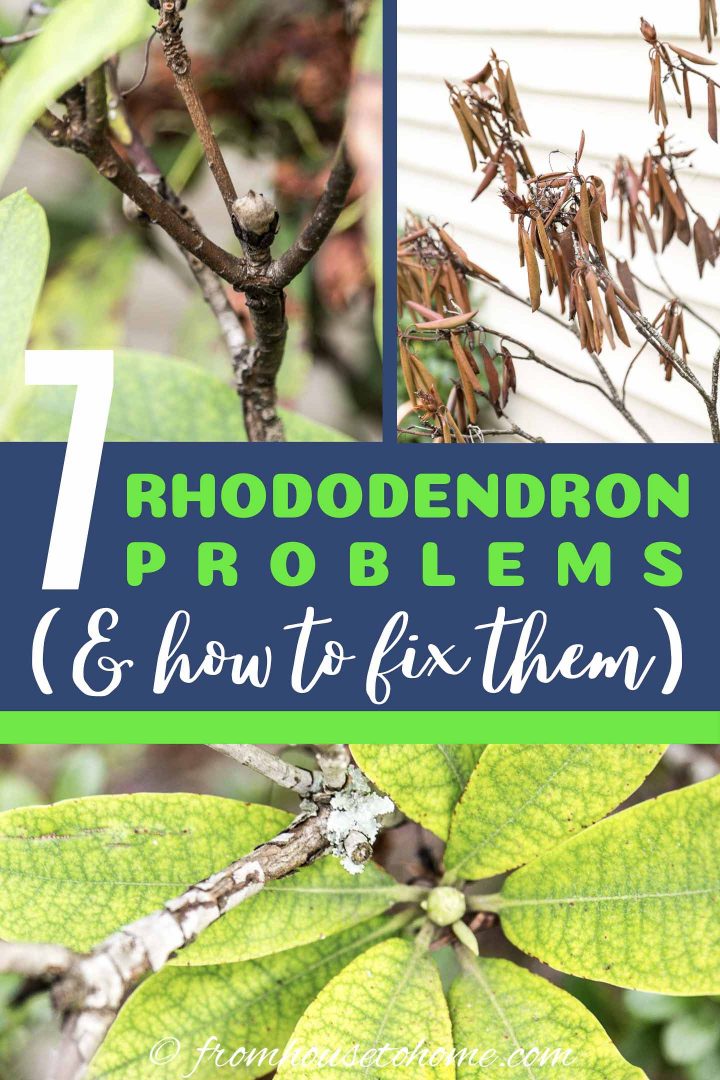
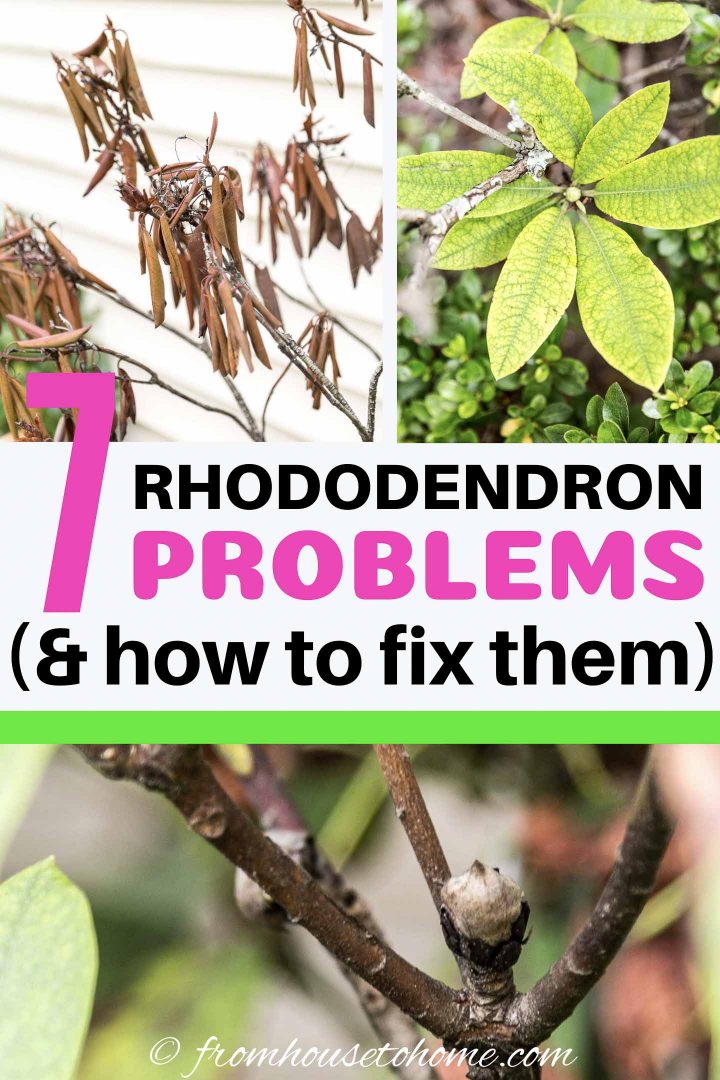
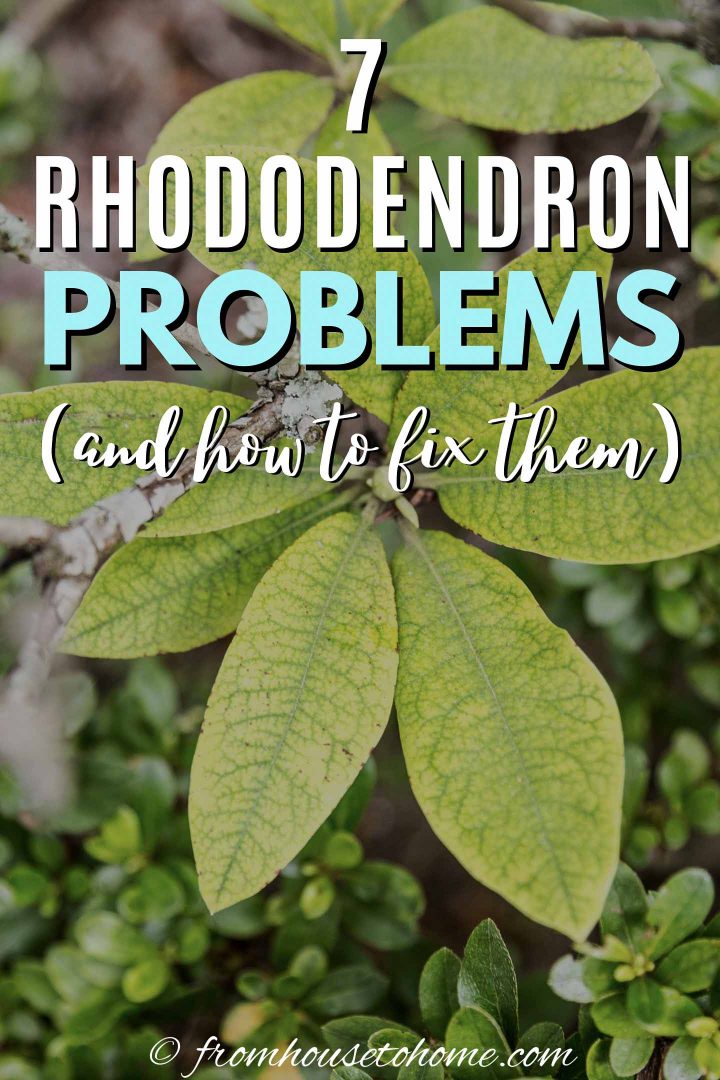
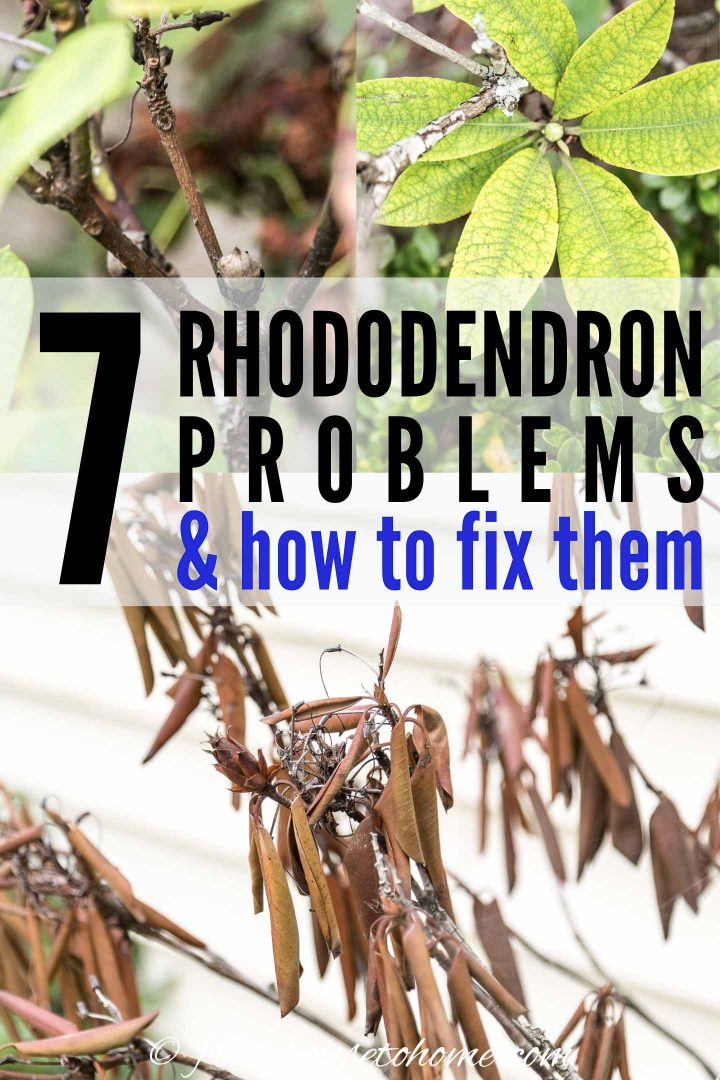
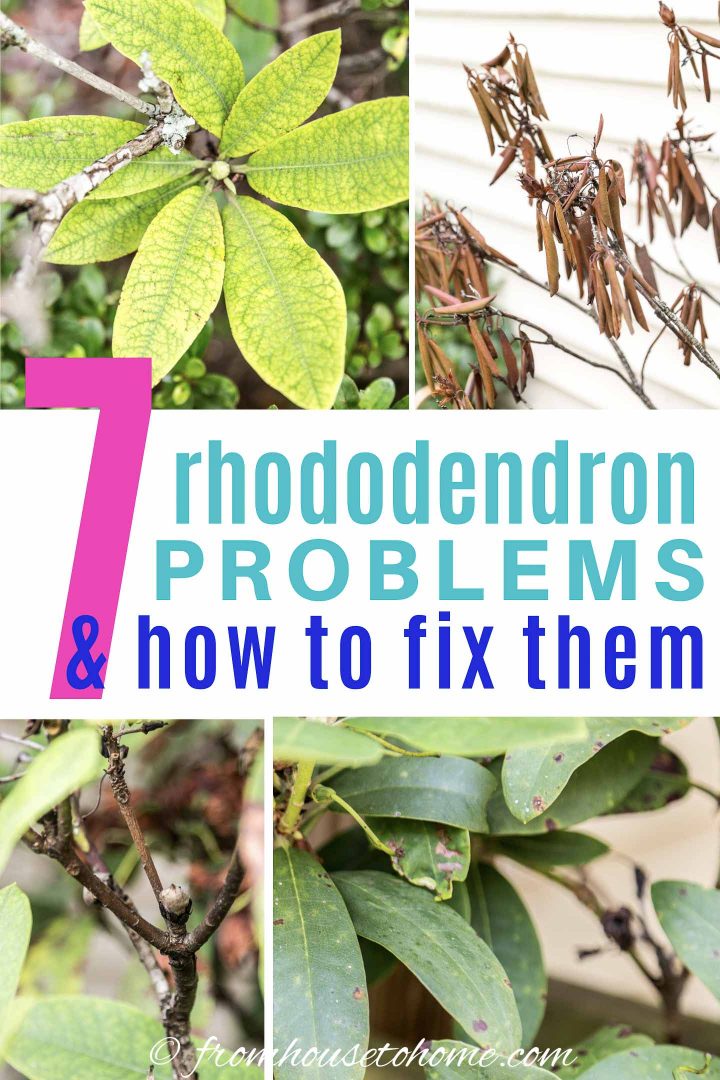

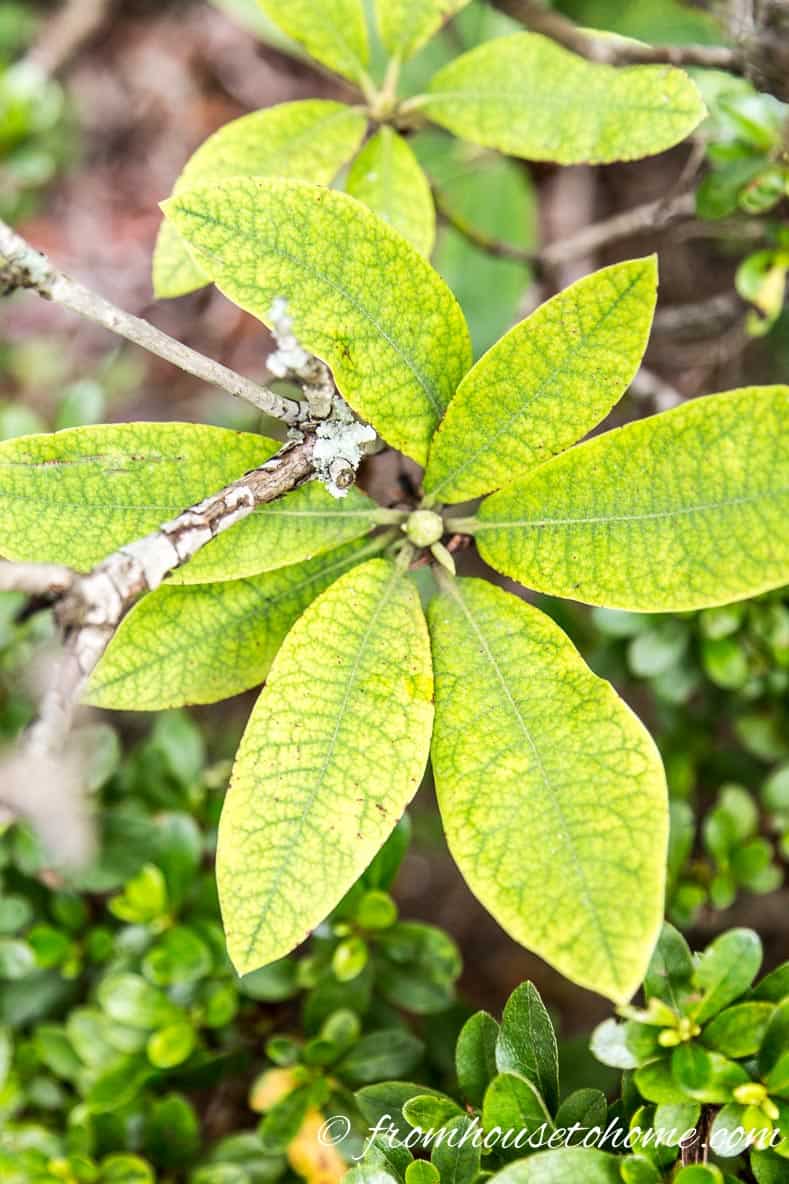
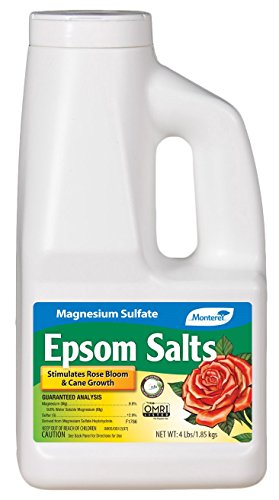
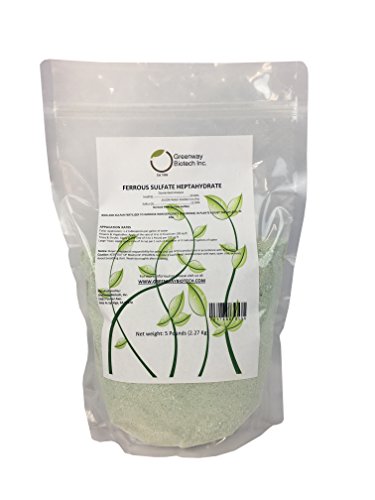
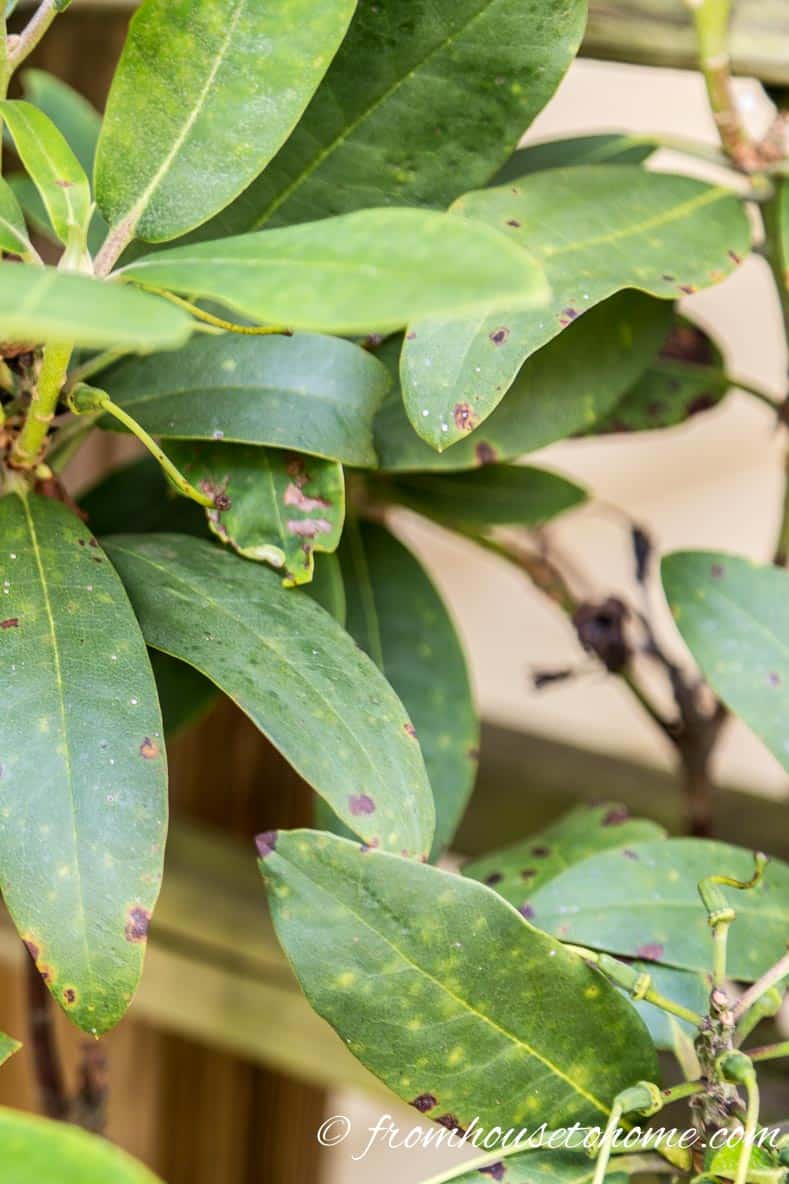
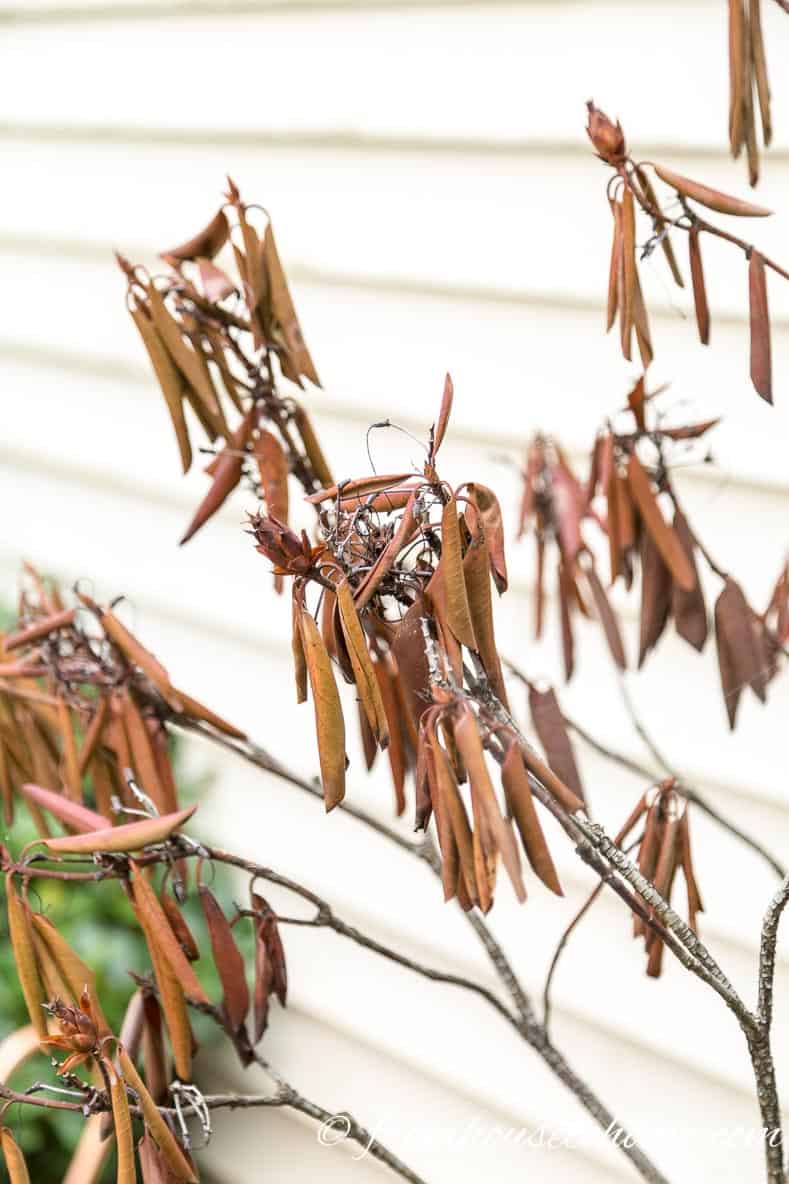
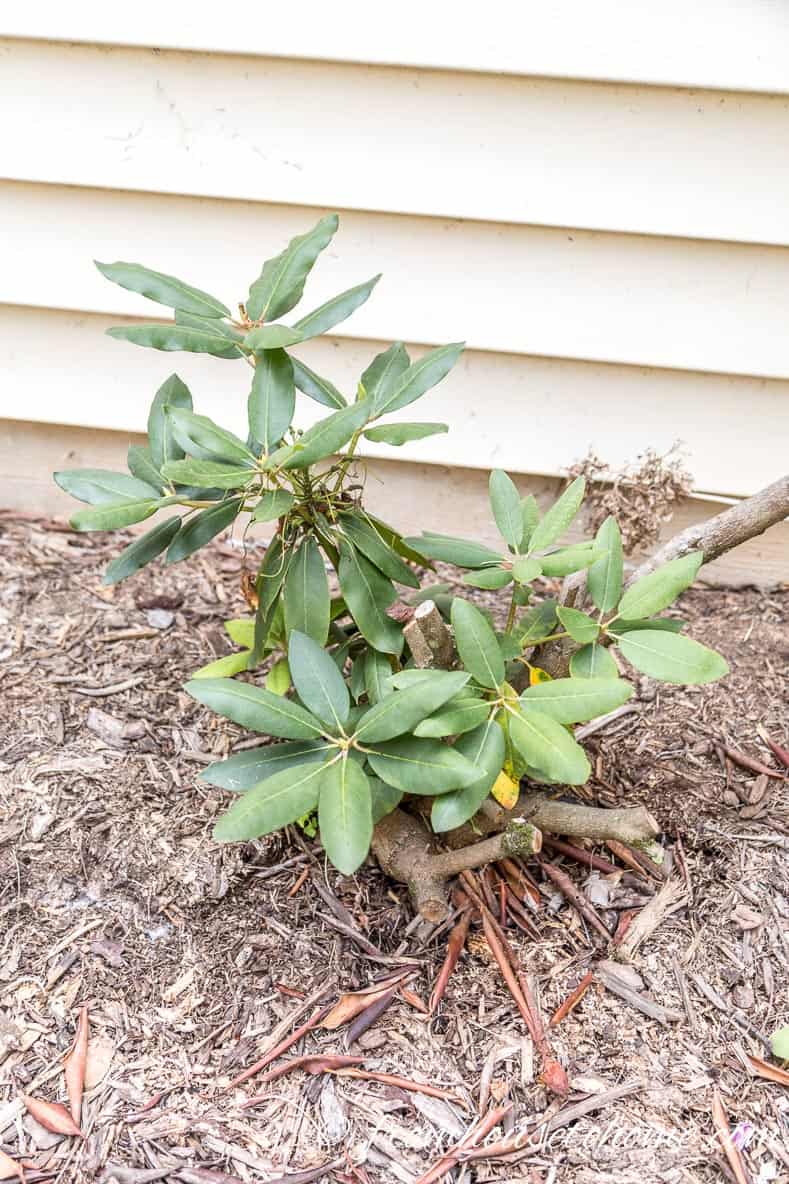
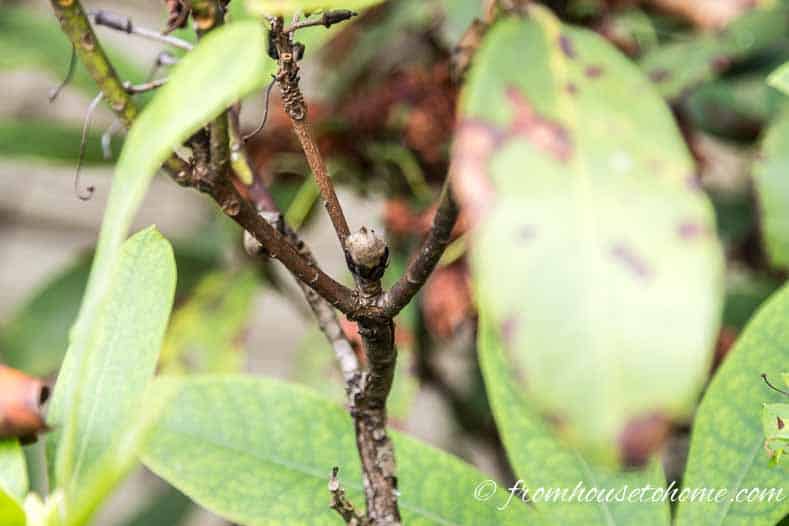
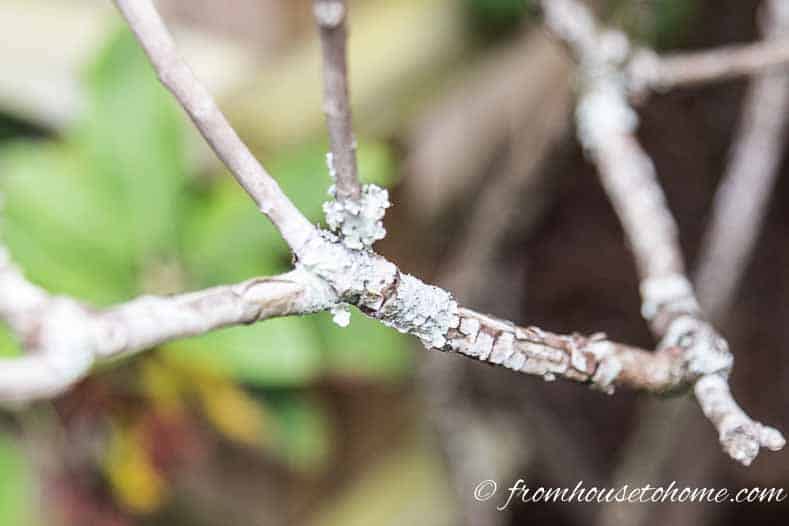

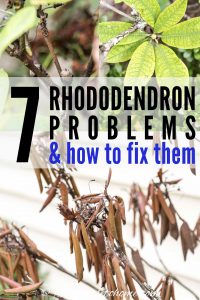
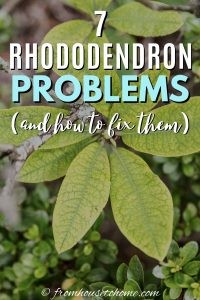
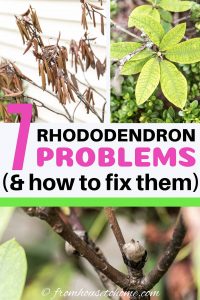
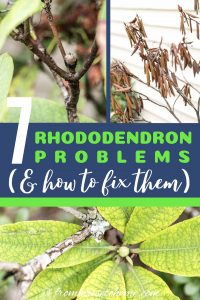
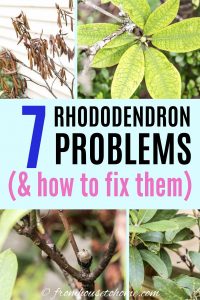
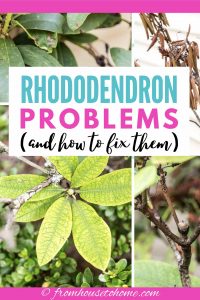
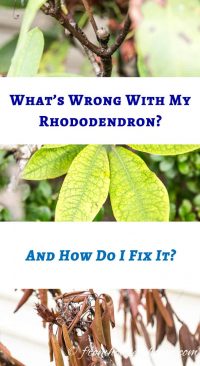
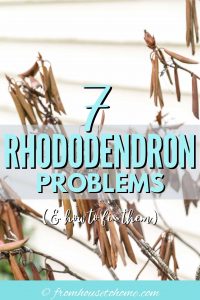
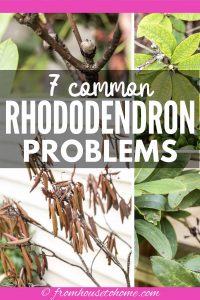
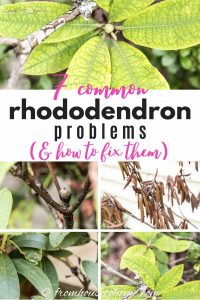
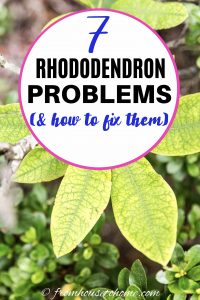
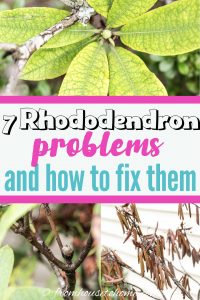
I have a Lavender Rhododendron that grew at a normal pace over the last Ten years. it is now about 8 feet tall and bloomed beautifully every year. The leaves always stayed greeni, although curled in the winter.
This year the leaves gradually turned brown. It looks as though it is dead?
We have had several years that the winter’s were much colder, more snow, the works. It always recovered from dormancy. I am in Woodbury Connecticut and I have seen this happen to other, larger Rhododendron close to me.
I don’t want to cut it back or down if I don’t have to. what should I do?
Hi John…I’m assuming since the plant has been growing successfully for a few years that you don’t have an issue with poor drainage or alkaline soil. So I would wait for a few weeks and see if it starts to put out new leaves. It is possible that the cold and snow finally took its toll (especially since it seems to be affecting other Rhododendrons in your area). If the branches are shriveled and brittle, it may not come back. But I have had Rhododendrons die back and then send up new shoots from the ground so watch for that.
I have a rhododendron bush that budded up last year (I live in south east England)… but has not flowered this year …. the leaves are also becoming a lighter green….
Hi Marianne…There could be a few reasons why your Rhododendron is not flowering and leaves are turning light green (or even yellow). 1. The most common cause is that there is a nutrient imbalance in your soil. To fix this, try adding a Rhododendron fertilizer following the directions on the box for how much / when to apply (Rhododendrons don’t like to be fertilized too much). Also, avoid fertilizers with too much nitrogen since it promotes lots of leaf growth without blooms. 2. The bush could be planted too deep. The rootball should be at or just below the surface and shouldn’t be covered with too much mulch. To correct this problem, you’ll need to dig up the plant and raise it. 3. Poor drainage. Rhododendrons don’t like wet roots so if the location it is in doesn’t drain very well, you may need to move it to a better spot (or fix the drainage issue). Hope that helps!
my rhododendrons bush only has a few flowers that have bloom we have had a very wet cool spring so far what can I do the buds look fine.
Hi Mary…the wet cool spring shouldn’t prevent the Rhododendrons from flowering unless the soil they are planted in doesn’t drain very well. Rhododendrons like lots of water, but they don’t like the soil to be soggy. If that’s the case, you can try to improve the drainage in the area. Otherwise, the blooms may just be a little slower than usual coming out because of the cooler weather.
My plants have coal black stems. What is that?
Hi Darlene…If you can scrape the black off, that is usually sooty mold which grows on the honeydew left behind by certain insects like aphids, whiteflies and scale. Wash the leaves with insecticidal soap to get rid of the insects and the black stuff should go away. If you can’t scrape it off, it is more likely to be one of the Rhododendron diseases that will eventually kill the plant. The rest of the plant probably won’t be looking very healthy either. In this case, you may want to take the Rhododendron out to prevent the disease from spreading.
I have four rhododendron bushes which were planted about four years ago. They are in a row in front of my home. The flowers have been “okay” on three of the bushes, although not full, and the 4th one is not growing and is scrawny with few buds each year! Is there a special fertilizer I should use to encourage their growth and blooms? The leaves look okay on all of them, but they don’t have the fullness I’ve seen on other bushes in the neighborhood. I am in Shelton CT. Any suggestions???
Hi Janet…I would try one of the fertilizers that are made specifically for Rhododendrons. If you do a search on Amazon.com for Rhododendron fertilizer, you’ll see a few different options come up. Look for ones that specifically say Rhododendron fertilizer (or food) on the packaging. They should tell you on the package how much to apply, but generally it’s not a lot. Since Rhododendron roots are so shallow, you can burn them if you put too much fertilizer on. Also, you’ll want to do it soon since this is the best time of year to fertilize Rhododendrons. Hope that helps!
Hi there
My rhododendron is over 30 years old. It is over 10 foot tall. Over 8 foot wide. It has strong growth and flowers prolifically.
My question is that it is now shooting from the base. It has five or six very green, strong shoots emerging from the base and heading straight up in to the middle of the existing plant.
I am worried the plant, being old, will eventually die off of old age. Should I cut the new shoots off or leave them on to regenerate the plant if the older growth has future problems. I’m worried the plant is feeding too much energy into the new shoots. The new shoots are very healthy. Your advice would be appreciated. Thanks.
Hi Gary…it sounds like you have a happy Rhododendron! As long as the rest of the plant is still healthy, I would let the new shoots grow. The only exception would be if they are causing the middle of the plant to be too crowded. In which case, you may want to cut some of them back to allow good air circulation.
I have a rhododendron shrub. The leaves had brown spots on them. I pulled the Leaves off. It bloomed one bloom this year. Should I cut the stems off that I pulled the Leaves off or leave them alone. Any help would be appreciated. Thanks. I do not want to lose the plant. I have it in my front yard. The stems wete i pulled the spotted leaves off are green.
Hi Linda…If the stems look healthy, I would wait and see if you get more brown spots on the remaining leaves. Make sure to clean up any dead leaves that are on the ground. If the brown spots do come back, then cutting off the stems is probably a good idea.
Thank you for replying. The stems look healthy but i have big brown spots on the leaves. I have a daisy plant that is close to it. Maybe it is being crowded out. I am thinking about moving it. Do they like full sun or partial shade. It did bloom on one branch. Will the leaves grow back on the stems that i pulled off. The stems are green or should i cut then off. Thanks.
Thanks so much for your reply! I’ll get the fertilizer from our closest plant sellers.
Hello
My Rhodedendrons have spots. Not any you mentioned. I’ve been researching and seems may be phytophthora or another disease. How can I tell and what can I do to save it?
Hi Larissa…I don’t have a lot of experience telling the difference between the Rhododendron diseases, but I found this article that does a pretty good job of explaining them, how to tell the difference between them and what to do about it. (Hopefully it’s not phytophthora because it sounds like there isn’t a cure for that).
The Rhododendron on the property I took over last year is struggling and has very few leaves this year. It had more last year but was still thin I wanted to prune, but was afraid to without knowing what I was doing. I also wanted to see the flowers as there were lots of buds.
This year it has bloomed nicely, but the lack of leaves make it look sickly. It is at least 25 years old and has had little to no care over the last decade. Should I prune it all back or is there a fertilizer to help it come back?
Hi Lois…I would probably try some Rhododendron & Azalea fertilizer on it first. And make sure it is getting enough water. Hopefully you’ll get a new set of leaves growing after the flowers are finished.
Hello Wanda, I have over 55 Rhodies on my property in Central Oregon. At least a dozen have little white pods all over the stems and crotches of the plant. When scraped they are bloody. They are not side-by-side and not all in the same area. Do you have a clue?
Hi Terry…That’s a lot of Rhododendrons. It must be beautiful in the spring with all of the flowers! I haven’t personally experienced that problem, but from your description it sounds like it could be Azalea Bark Scale. I found this article that has pictures and some suggestions on how to treat it. So hopefully that helps.
What can be done about dropping leaves after blooming? They have dropped several green leaves over the last two weeks without any indication that there is any other problem. We’ve had a wet spring, but other rhododendrons, planted in similar conditions but about 50′ away, are not dropping leaves.
Hi Carl…The dropping leaves can be a sign of too much water. It’s possible that the soil where these Rhododendrons are planted doesn’t drain as well as the other locations. Since you’ve had a wetter spring than usual, they will likely recover when the soil dries out.
Hi … I live in New England, and my usually healthy Rhododendrons have now developed light-colored growths (about the size of ping-pong balls) of what looks like a a mushroom-type fungus/growth? I have tried to research them, but can find nothing about them. Any ideas? Thank you!
Hi Suzanne…I haven’t experienced those myself, but it sounds like it could be a fungus called Azalea Leaf Gall. You can find more about it here: https://www.gardeningknowhow.com/ornamental/shrubs/azalea/azalea-leaf-gall.htm.
Hello, I got a smaller rhododendron as I live in a apartment last year. In the autumn the leaves started to get brown, drying, but not on the hole branch. I just fertilize it and it seems that it has flowers. Should I do something else or what can be the cause?
Reading your post I think that it can be the lack of water and the shade that is present almost all morning on our balcony.
Grateful for the answer.
Hi Alina…it probably is the lack of water. Rhododendrons don’t like to get dried out. Too much shade would affect the flowers more than the leaves. Since you are still getting blooms, it sounds like that isn’t too much of an issue.
Hi. My Rhodie is about 13 years old and and about 8-10 feet tall… it has gradually started leafing out only on the top, sometimes it blooms, sometimes not. It looks really bad this spring, almost dead-looking, with just leaves on top. Can I do anything to save it? Thank you
Hi Julia…I would first check to see if there are any growing conditions that have changed over time and need to be fixed. Has the drainage changed so it’s getting too much water? Or has the soil built up over the roots (or anything else on top of the roots that wasn’t there before)? Are there other plants that have gotten bigger and may be interfering with the Rhododendron’s roots or causing it to get too much shade? Is there any evidence of insects or disease? If none of those seem to be the case, you may just have a short-lived plant. As a last-chance effort, you can try cutting the stems down to a few inches above the ground and see if it starts growing again. Hope that helps!
Thank you for commenting back. I will check on these things.
I have had rhododendrons in front of my house in the middle of the yard for ten years, each year they have not grown very well. They are small, the leaves look kind of wilted and yellowish. The plants are not dead but are small not even 3 ft tall. Do you know my problem.
Hi Andy…it could be a few things: 1. The Rhododendrons are planted too deep (the root ball should be very close to the soil line). 2. They aren’t getting enough water. Or 3. The soil isn’t acidic enough. For this last one, you can try sprinkling soil acidifier around them to see if it helps. Good luck with them!
my rhodo is some years old and I live in N.ireland .I have noticed a lot of the leaves and some of the branches have turned black and buds are not prospering.
Hi Colum…There are a couple of potential causes for your Rhododendron issue:
If it is a black substance growing on top of the bark and leaves, then it’s probably sooty mold. It grows on the honeydew left by insects like aphids and white flies. In this case, you can wipe the mold off, but will need to get rid of the insects to prevent it from coming back. (Washing with insecticidal soap is useful for killing many types of insects).
If the bark itself has actually turned black, that is probably not a good sign. It usually means your plant has a disease such as Botryosphaeria canker or Phytophora root rot. If there is a nursery in your area that does plant testing, they can tell you for sure what it is. But in some cases (like Phytophora root rot), it is best just to take the plant out. If you want to try to save it, make sure it isn’t getting too much or too little water, prune off the diseased branches and give it some Rhododendron fertilizer to see if it will grow back.
Hi, I have a rhode whose leaves are yellow, droopy, and the bush basically looks like it is dying. I dug a hole 12″ down at the perimeter of the overhang and the soil was damp. The bush is about 15 years old, and last year bloomed profusely. I had a rhododendron planted in the general area that did the same thing and died last year. Can I save this plant? If so, what can I do to help it?
Hi Sharon…yellow leaves usually mean that the Rhododendron is unhappy with the soil – either it’s getting too much or too little water, or the soil isn’t acidic enough. You could try adding some Rhododendron fertilizer to see if that helps. (Since you had another one die recently in the same area, it could also be some kind disease, in which case, there’s probably not much you can do).
Hi, my problem is droppy curled leaves. It started after they blossomed about 5 weeks ago. It looks like it’s dying but it didn’t happen till after blossoming. I had a beautiful display this year, better than in years past. Have some leaves falling and a few dead branches at the bottom of the plant. Does it need fertilizer? It is mostly in the shade. Thank you for any help you can give me.
Hi Nancy…that often happens if the plant is under stress due to extreme temperatures (hot or cold) or lack of water. Fertilizer probably isn’t a good idea. I would cut back the dead branches, make sure it is mulched well and that it is getting enough water. Hopefully it will come back.
My rhoddie is about 15 years old. Has done well in past. This season it did produce leaves and the ones that are left are turning brown and falling off. I have used rhoddie fertilizer, iron supplements, and water. The roots are very thick but don’t appear dead. What can I do?
Hi Amber…Unfortunately it doesn’t sound too promising. When the leaves all start dying, it usually indicates one of the Rhododendron diseases that can’t be cured.
Hello
We moved to a property on Vancouver Island with 2 Anah Kruschke rhododendron bushes in a bed in front of the house. The foliage looks healthy, and there are a couple of normal sized flower buds on each bush, but most of the buds are tiny, as if they got stalled somewhere in their development. They are not discoloured just tiny and unpromising. It does not look like they were mulched, would that be the cause of the stunted buds?
Hi Janine…the smaller buds are usually leaf buds rather than flower buds. The lack of mulch could be the issue, since it helps to keep the soil moist. And dry conditions are a contributor to fewer flowers. I would also try adding a Rhododendron fertilizer to see if it helps with the bud production for next year.
Hi, I am writing with a question about the dieback.
We purchased a home last year NC Sandhills with mostly several large rhododendrons, several of what I believe are heirloom azaleas, holly, camellia, and dozens and dozens of long leaf and other pine. The soil is sand, drains well, and is plenty acidic.
All of the Rhodos have die back to varying degree of severity, some have bud blast, and I’m pretty sure that was lace bug evidence I saw when pruning back an azalea today. These plants, as far as I can tell, all recieved regular watering from a well that recirculates the ground water on the property. And all were planted no later than 2005 and no earlier than 1988. When we moved in we had so much else to deal with we didn’t reset sprinklers which had been off for probably at least 2 yrs. This may very well have stressed these plants like a drought would. They show signs of having been pruned rather severely, 1″ (give or take) stems show cut marks at about 2 feet in some places, sometimes a little lower. Then they were left to just…. grow. Some of those azalea branches today were a good 4 to 5 feet with only 1 branch spread midway and one at the top. These plants are all leggy and overgrown, many very twiggy and bare stemmed on the interior of the plants. And then with the die back, some really are sparce after taking out sick wood last year, but now seem to have new spots of brown blotches and drab dry curled leaves. I cut 2 very sick rhododendrons to stump last year but was delayed in digging them up, when they came back I transplanted them last fallish. My question is, are we waging a losing battle? Are the sparse and still sfalling plants just going to die slowly over the next couple years? Are those transplants going to grow back with die back fungus in their system, and am I contaminating that soil in the process? I am new to these plants, and feel like the brownish red stem color under last year’s growth is not a good sign (overall I see that, green, ashy white, and what looks like a healthy brown on even a single rhododendron throughout the property). With so many problems in so many plants, what do you recommend? The plants you cut to stump and showed in this article, was that due to die back? Did they come back healthy, or still infected? Sorry for so much back story, it dawned on me today some of their experience before we moved in could have caused or exacerbated the problem, and some of the info may be helpful. We’d prefer not to lose them, especially certain ones. But if we are going to nurse them while they die anyway for the next few years I’d rather take them out now and spend that time watching new healthy ( different species) plants grow! And get the potentially sick transplants out before they contaminate the soil if I want rhododendrons or azaleas there still. ( it’s been less than a year maybe closer to half, with no leaf drop or anything yet, is that soil likely safe still?) A HUGE thank you in advance!!!!
Hi Emily…first, it is possible that some of the brown spots, bud blast and dead leaves you are seeing is due to under-watering (the symptoms look pretty much the same as dieback). In this case, you’ll usually see the brown spots forming on mature leaves and buds all over the plant, then spreading to stems and new growth. These plants can often be saved by removing all of the diseased leaves, cutting back the stems to the next set of healthy leaves, making sure dead leaves are cleaned up around the plants, improving the watering and making sure they are mulched well. If the plants die back one stem at a time, then it’s more likely that you have dieback fungus in the plant. It is possible to treat it the same way as above if it’s only in part of the plant (and not in the soil). For the plants that you transplanted, do you happen to remember what color the roots were? If they were brown (as opposed to a healthy white color), the fungus is likely in the soil and those plants should be destroyed. Otherwise, if you were able to cut them back far enough to see healthy looking inner stems they may be fine. My Rhododendron did have dieback that ended up being in the soil (brown roots), and although it came back for a while, it ultimately didn’t make it. And I will say that nursing Rhododendrons back to health is a lengthy process which isn’t always successful. So whether you decide to try to bring them back or start over from scratch depends somewhat on how much patience you have 🙂
Hello, I have 6 rhododendrons that are well established but fairly leggy. The were planted 20 years ago, though we just moved here 4 years ago. In the past 4 years I have NEVER seen them bloom. The buds are little, but look healthy.
Their leaves look healthy for the most part. They have decent sun/shade and I’ve tried fertilizing them with Hollytone, but still no luck. We live on the seacoast of NH. Any advice would be greatly appreciated! Thank you!!
Hi Robin…I suspect those small buds are actually new leaves and not flowers. The most common reasons for Rhododendrons not to bloom is pruning or fertilizing at the wrong time, and too much or too little water. Pruning generally isn’t necessary, but if you’re going to do it, make sure to do it in the spring (if the plants are blooming, it should be done immediately after they’re finished). If the plants have been cut back severely, it can take 3 or 4 years for them to start blooming again. Similarly, fertilizing should be done in the spring, not in the summer or fall. For watering, Rhododendrons like consistently moist soil, so watering is important. But they don’t like to be soaking wet, so make sure the soil is draining properly. Since their roots are shallow, a 3″ to 4″ layer of mulch helps to keep them moist. I hope that helps!
Hi, I have a Rhododendron about 25 yrs old. I noticed this spring the leaves turning brown and wilting. When I checked it out I noticed a “hole” in the bush and it turned out to be the truck is split about a foot and a half up. Is there anything I can do to save it. The part of the trunk that is hanging down causing the hole in the bush is mostly where the dying and browning leaves are,but the other part of the trunk still upright the leaves are starting to brown and wilt. It is full of large buds and I’m hoping there is some way to save the plant other than to cut it off below where the split is. Can you help me??
Hi Martin…I think you should cut off the part of the trunk that is hanging down. Try to make a clean cut and then cover the cut end on the remaining plant with pruning seal. Then wait for a few weeks and see if the rest of the bush survives. You may end up having to cut it all down below the split, but I would at least give it a chance to recover.
I transplanted my little rhododendron in the fall when we moved and in the spring there was an overabundance of flowers but few leaves. Poor thing doesn’t look well. Not sure if I should cut the old flowers off; whether I should water more or less; fertilize or just leave it along and see what happens as the summer begins. I’ve heard when plants produce a lot of flowers or, say, pine cones they are beginning to die. Your comments would be really appreciated.
Hi Pam…I haven’t heard of Rhododendrons producing a lot of flowers before they die (at least in my experience, they usually stop producing flowers when they are not doing well). I would wait and see if new leaves come out after it has finished blooming. Taking the old blooms off wouldn’t hurt, just make sure to only remove the spent flowers since the new leaves will come out right underneath them.
new rhododendron plants buds not forming properly shooting and very sticky heads
Hi Audrey…it sounds like your Rhododendrons might have sap-sucking bugs like aphids, scale or Rhododendron leafhopper. You should be able to get rid of them by washing both sides of the leaves with insecticidal soap.
Hi Wanda,
We planted 3 very healthy Rhododendron-Nova Zembla in the spring and they bloomed beautifully. Soil is rich, I add compost every year and this year I added acidfier as the soil tests suggested. After they died back, I deadheaded the brown flowers off about10 days ago. Now there are large oval brown spots in the middle of many leaves. Until now, they were fine with no problems. We have an irrigation system and rain this season in the western part of Virginia is a bit dry to normal. We planted three Lemony Lace Elderberries in front of the rhododendron and their leaves on the upper branches have a bit of brown streaks in them but not like the rhododendron. Any ideas of what if anything can be done? Thanks,
Hi Bill…Brown spots on Rhododendron leaves are usually caused by fungal diseases or watering issues (either over or under watering). It sounds like you have the watering under control, but I would check to make sure there aren’t any drainage issues. If it is fungal, you can pick off the brown leaves and/or try applying a fungicide. Then make sure to clean up any leaves that fall so it doesn’t spread.
Our Rhododendron is having a problem. One side looks good one side the leaves are wilting. They are not turning brown yet but are looking unhealthy. It is entirely in the shade with a little filtered sunlight! What should we do!
Hi…Unfortunately, wilting leaves like that is usually a sign of a fungal disease. You may be able to stop it from spreading to the other side of the plant if you cut off all the affected branches and also make sure to clean up any leaves from the ground.